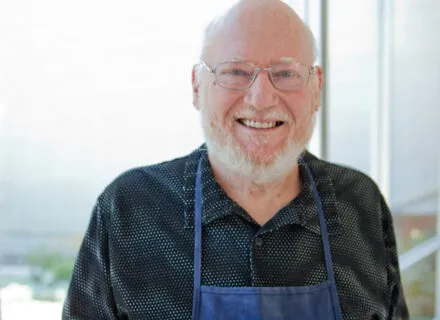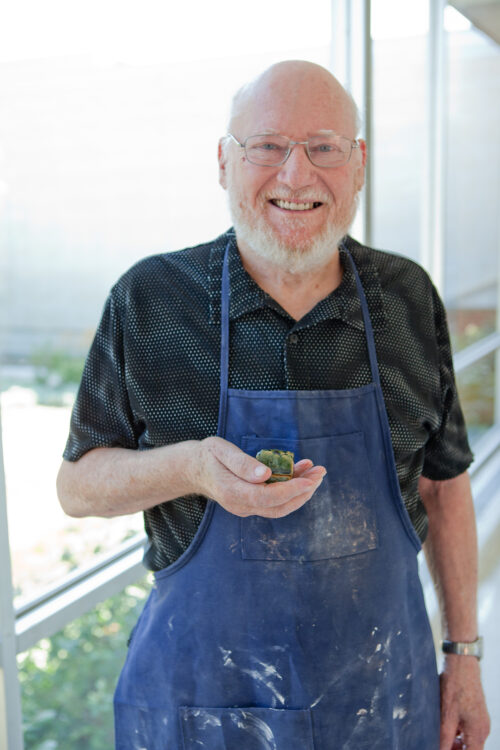
Alvin Doyle Moore
Inducted in 2024
Alvin Doyle Moore was a graphic design faculty member at the School of Art and Design at University of Illinois Urbana-Champaign, where he taught for over 30 years – aligning his teachings with his diverse interests, including cooking, folk music, autoharp, ceramics, printing, paper making, book binding, textile design, weaving, knitting, lace-making, sweet-making, flower arranging, and tea ceremony.
Moore graduated from high school in Garden City, Kansas, and received a scholarship to study architecture at Kansas State College. During this time, he had a choice to be drafted into the army or to enlist. He chose to enlist in the Air Force which gave him the opportunity to live abroad in Japan. His background and talents led him to become the art director for the “Stars and Stripes” publication where he had the chance to deepen his understanding of design and how to effectively communicate stories. While in Japan, he was exposed to Japanese arts and was particularly taken by Japanese flower arranging. He returned to Kansas State where he received a Bachelor of Science in Humanities with an art and painting option, a minor in interior design, and essentially a concentration in architecture. Following this, he attended the University of Iowa to work on a master’s degree, and was then hired by the University of Illinois in 1959, where he eventually became head of the graphic design program.
In 1964, he met Professor Shozo Sato, founder of the original Japan House. The two became close friends after Sato invited Professor Moore to his first tea ceremony. From that day forward, Professor Moore immersed himself in the world of tea and started studying tea intensely under Sato. After several years of studies, Professor Moore was admitted to study tea at Dai-Nihon Chado Gakkai in Tokyo, Japan and took intensive lessons which eventually earned him a professional tea name, Do-sen, and master’s license to teach tea. Professor Moore became fully committed to sharing the Way of Tea on a volunteer basis at the original Japan House alongside Professor Sato and Professor Kimiko Gunji and was recognized by his students of tea as Doyle Sensei.
Teaching was an extension of who Doyle Sensei was. His endless curiosity about the world in which he lived and how he was able to find beauty and relationships in the often overlooked or expected things in our daily lives was an aspect of his teaching that he shared with students so they too would find these relationships and see the world with more openness and scrutiny. His students valued these lessons that he shared with them and had the opportunity to see how their interpretation of his philosophies would come to life in their own design work and tea studies.
He believed that his teaching was always about how things go together, and it is only through careful observation and exploration of relationships that design is possible. After retirement, Professor Moore almost exclusively shared his time teaching at Japan House. He was a fixture in so many ways at both the original Japan House and at the current Japan House – teaching, making sweets, researching aspects of the Way of Tea that were less explored – such as the significance of patterns in the textiles that are showcased in tea; the art of incense (koh-do); the craft of incense containers; the artistry behind bamboo crafts; and so on and so forth. He voraciously would research these topics and read any and all materials he could find that was in English and then present his findings to all of the students at Japan House and for many open house presentations.
Moore was actively involved in both local and national Folk music circuits. Locally, he played autoharp in the Philo Glee and Mandoline Society folk band. He also used his printing business to create posters, flyers, and album covers for the local Campus Folksong Club at the University of Illinois. The Campus Folksong Club drew many important Folk music acts to the Champaign-Urbana area including Flatt & Scruggs, Red Craven’s Bray Brothers, The New Lost City Ramblers, The Stoneman Family and Hedy West. The Club also hosted a 1963 lecture series that included Doyle Moore and Archie Green, who presented his lecture “Hillbilly Music: Source and Symbol,” which opened the door for country and folk music as serious scholarly areas of research. Nationally, he used his business to create album covers for national folk music publishers like Folkways Records and Folk-Lyric Records. He also labored to make the autoharp more visible within the folk music community at large with his publication “The Autoharp” as well as his seminal essay “The Origin of the Autoharp,” presented in the 1963 lecture series.
